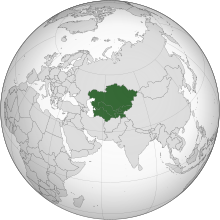 | |
| Area | 4,003,451 km2 (1,545,741 sq mi) |
|---|---|
| Population | 75,897,577 (2021) (16th)[1][2] |
| Population density | 17.43/km2 (45.1/sq mi) |
| GDP (PPP) | $1.25 trillion (2023)[3] |
| GDP (nominal) | $446 billion (2023)[3] |
| GDP per capita | $5,900 (2023; nominal)[3] $16,400 (2023; PPP)[3] |
| HDI | |
| Demonym | Central Asian |
| Countries | |
| Languages | Dungan, Karakalpak, Kazakh, Koryo-mar, Kyrgyz, Mongolian, Russian, Tajik, Turkmen, Uyghur, Uzbek, and others |
| Time zones | 2 time zones
|
| Internet TLD | .kg, .kz, .tj, .tm, .uz |
| Calling code | Zone 9 except Kazakhstan (Zone 7) |
| Largest cities | |
| UN M49 code | 143 – Central Asia142 – Asia001 – World |
a With population over 500,000 people | |
This is a select bibliography of English language books (including translations) and journal articles about the history of Central Asia. A brief selection of English translations of primary sources is included. Book entries have references to journal articles and reviews about them when helpful. Additional bibliographies can be found in many of the book-length works listed below; see Further reading for several book and chapter-length bibliographies.
Inclusion criteria
Geographic scope of the works include the present day areas of: Kazakhstan, Kyrgyzstan, Tajikistan, Turkmenistan, Uzbekistan, and peripheral regions such as Afghanistan, Afghan Turkestan, Caspian Sea, Mongolia, East Turkestan, Xinjiang, and Iran as they relate to the history of Central Asia.
Included works should either be published by an academic or notable publisher, or be authored by a notable subject matter expert and have positive reviews in significant scholarly journals.
Formatting and citation style
This bibliography uses APA style citations. Entries do not use templates; references to reviews and notes for entries do use citation templates. Where books which are only partially related to Central Asian history are listed, the titles for chapters or sections should be indicated if possible, meaningful, and not excessive.
If a work has been translated into English, the translator should be included and a footnote with appropriate bibliographic information for the original language version should be included.
When listing works with titles or names published with alternative English spellings, the form used in the latest published version should be used and the version and relevant bibliographic information noted if it previously was published or reviewed under a different title.
- ^ "World Population prospects – Population division". United Nations. Archived from the original on February 5, 2019. Retrieved July 16, 2019.
- ^ "Overall total population" (xlsx). United Nations. Archived from the original on February 18, 2020. Retrieved July 16, 2019.
- ^ a b c d International Monetary Fund. "World Economic Outlook Database, April 2023". International Monetary Fund.
© MMXXIII Rich X Search. We shall prevail. All rights reserved. Rich X Search
